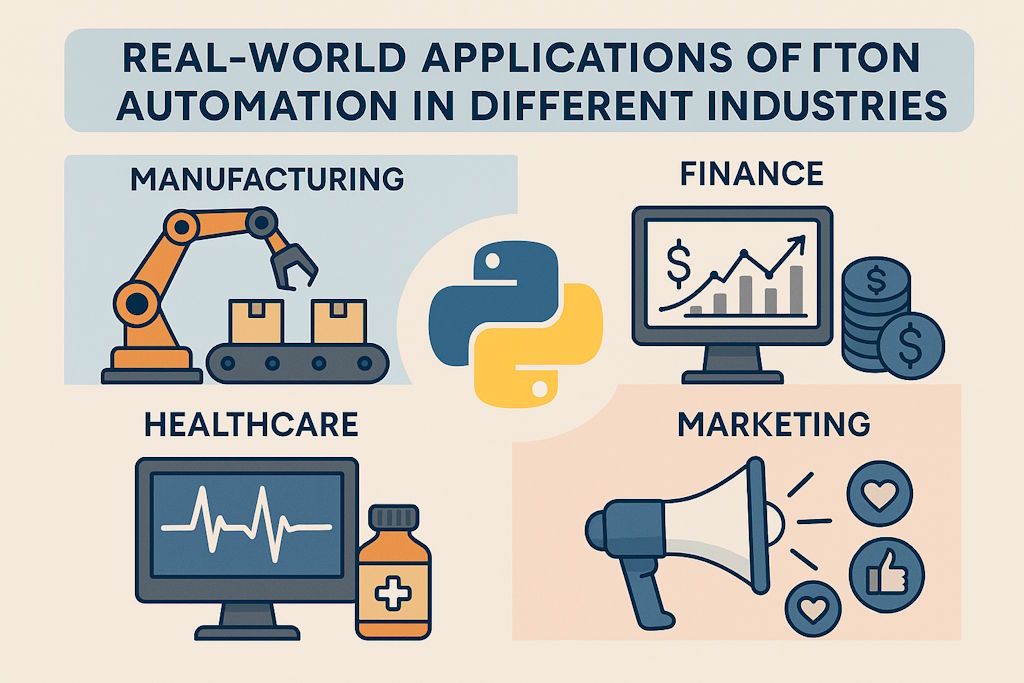Python is one of the most popular programming languages today, known for its simplicity, versatility, and ability to handle automation tasks efficiently. Python automation allows businesses across various industries to automate repetitive tasks, improve efficiency, and save time.
Whether it’s managing data, automating customer service, or handling system administration tasks, Python for automation provides scalable and reliable solutions.
In this article, we will explore real-world applications of automation across different industries and how businesses are leveraging this powerful tool to streamline their operations and gain a competitive edge.
What Is Python Automation?
Python automation refers to using the Python programming language to automate tasks that would typically require manual input or human intervention. This can include data processing, file management, web scraping, scheduling tasks, and interacting with APIs.
Python's simplicity, along with a robust ecosystem of libraries and frameworks, makes it a go-to solution for developers and businesses looking to automate workflows.
Python’s popularity in automation comes from its ability to integrate easily with other tools, its open-source nature, and its vast community support. Whether you're looking to automate simple daily tasks or complex workflows, Python offers the flexibility needed to get the job done.
Benefits of Automation with Python
Before we dive into the specific applications, let’s review the key benefits that automation with Python offers to businesses:
- Time-saving: Automating repetitive tasks can save hours of manual work, freeing up employees to focus on more strategic tasks.
- Accuracy and reliability: It reduces the risk of human error and ensures that tasks are executed consistently and correctly.
- Cost-effectiveness: By reducing manual labor, Python for automation helps businesses lower operational costs and improve overall productivity.
- Scalability: Python automation solutions can be scaled easily to handle increased workloads or more complex tasks.
- Flexibility: Python can be used to automate a wide range of tasks across various systems and applications.
Real-World Applications of Python Automation in Various Industries
1. E-commerce and Retail
Python automation plays a significant role in the e-commerce and retail sectors, helping businesses streamline processes and improve customer experience.
Inventory Management and Stock Monitoring
E-commerce businesses often struggle with inventory management, especially when dealing with extensive inventories or multiple warehouses. It simplifies this by automating stock monitoring and updates. Python can be used to automatically track inventory levels, send notifications when items are low in stock, and even reorder products from suppliers.
For example, Python scripts can be integrated with a company’s database to automatically update the stock levels as orders are placed or returned. This eliminates the need for manual updates, reduces human error, and ensures inventory data is always up-to-date.
Price Scraping and Competitive Analysis
For retailers, monitoring competitors’ prices is critical for staying competitive. Python for automation allows businesses to scrape competitors' websites and collect pricing information automatically. This data can be analyzed to adjust pricing strategies in real-time, ensuring that companies offer competitive prices.
It can also be used to track product availability across various platforms and adjust prices based on market demand, further enhancing a retailer’s ability to respond quickly to market changes.
2. Finance and Accounting
Python automation is increasingly used in the finance sector, where it helps with tasks ranging from data analysis to report generation.
Data Processing and Analysis
The finance industry deals with large volumes of data that need to be processed and analyzed. Python for automation can streamline these tasks by pulling data from multiple sources (e.g., financial statements, stock market feeds, customer transactions) and performing calculations or analyses automatically.
Python’s powerful libraries, such as Pandas and NumPy, allow for complex financial analyses, like risk assessment, portfolio optimization, and forecasting. Automating these processes saves time, reduces the risk of errors, and enables finance professionals to focus on higher-level decision-making.
Invoice Processing and Tax Calculation
For accounting departments, automation can simplify the process of invoicing and tax calculations. Python can be used to automate the generation of invoices based on specific criteria (e.g., services rendered, product sales), ensuring accuracy and consistency. Additionally, it can be integrated with tax calculation software to automatically calculate and apply taxes based on local regulations, minimizing manual work and reducing errors.
3. Healthcare
The healthcare industry is increasingly turning to Python automation to improve patient care, streamline administrative tasks, and enhance operational efficiency.
Patient Data Management
Managing patient records and ensuring they are up-to-date and secure is a significant challenge in healthcare. It can help streamline this process by automating data entry, updates, and transfers between systems.
For example, Python can be used to automatically update patient records from different sources, such as appointment systems, medical devices, and lab results, ensuring that doctors and healthcare providers have the most current information at their fingertips.
Medical Billing and Claims Processing
Medical billing and claims processing are time-consuming tasks that can benefit significantly from Python automation. Python scripts can be used to automate the generation of medical bills, submission of claims to insurance companies, and tracking of payment statuses.
By automating these processes, healthcare providers can reduce billing errors, speed up claim processing, and ensure more timely reimbursements from insurance companies.
4. Manufacturing
Manufacturers rely on Python automation for tasks that range from supply chain management to machine monitoring.
Supply Chain Automation
Managing a supply chain involves coordinating multiple vendors, inventory levels, transportation, and delivery schedules. It can help by automatically tracking supply chain data, sending notifications when stock levels are low, and triggering automatic reorder requests. This reduces delays and helps manufacturers maintain production schedules without overstocking or running out of materials.
Predictive Maintenance
In manufacturing, equipment downtime can lead to costly delays. It can help predict when equipment is likely to fail by analyzing sensor data from machines and identifying patterns that indicate wear or potential breakdowns. Python’s machine learning libraries can be used to create predictive models that notify operators when maintenance is required, reducing downtime and saving costs.
5. Marketing and Customer Engagement
Marketing teams also benefit from Python automation, especially in areas related to data analysis, customer segmentation, and campaign optimization.
Social Media Monitoring and Sentiment Analysis
Python for automation allows businesses to monitor social media platforms and analyze customer sentiment automatically. Python’s natural language processing (NLP) libraries can be used to analyze text data from social media posts, reviews, and customer feedback to determine public sentiment about products or services.
This information can be used to adjust marketing strategies, identify trends, and respond to customer concerns in real-time, improving customer engagement and brand reputation.
Email Marketing Automation
It can also be used to optimize email marketing campaigns. Python scripts can be used to segment email lists, personalize email content, schedule campaigns, and track performance metrics such as open rates and click-through rates.
By automating these tasks, marketers can deliver targeted campaigns to the right audience at the right time, improving campaign effectiveness and reducing manual work.
Getting Started with Python Automation in Your Business
To implement Python automation effectively, businesses should follow a structured approach. Here are some steps to help get started:
- Identify Repetitive Tasks: Start by identifying the tasks or processes that are repetitive and rule-based. These are the ideal candidates for automation.
- Select the Right Python Libraries: Python offers a wide variety of libraries to assist with automation, such as Pandas, NumPy, OpenCV, and Selenium. Choose the ones that best suit the tasks you want to automate.
- Develop and Test Automation Scripts: Once you've identified the tasks and chosen the libraries, write and test Python scripts to automate the processes. Testing is essential to ensure that the scripts run smoothly and produce accurate results.
- Integrate Automation with Existing Systems: For seamless automation, integrate Python scripts with your existing business systems, such as CRM, ERP, or document management software.
- Monitor and Optimize: Automation is not a one-time task. Continuously monitor the performance of your automated processes and optimize them as needed to improve efficiency and accuracy.
Conclusion
Python automation offers businesses across various industries a powerful tool to streamline operations, reduce costs, and improve efficiency. Whether you're looking to automate tasks in e-commerce, finance, healthcare, or manufacturing, Python provides a flexible and scalable solution.
By integrating automation into your business, you can stay ahead of the competition, enhance productivity, and create a more seamless experience for both employees and customers.
With its simplicity, flexibility, and powerful libraries, Python is one of the best choices for businesses looking to automate and innovate. Start identifying areas for automation with Python today and experience the benefits of faster, more accurate, and more efficient business processes.








